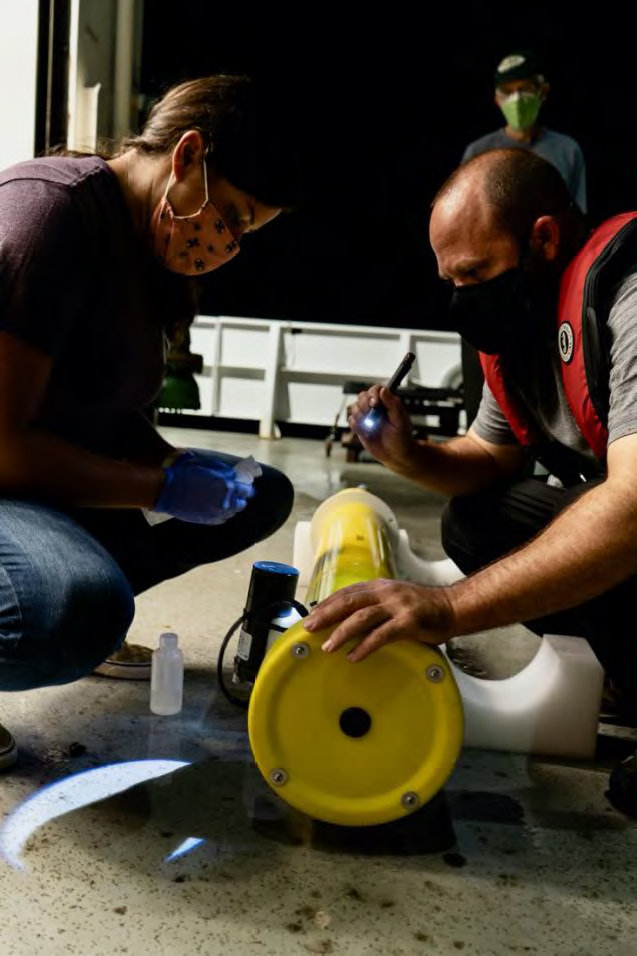Greetings from the Gulf of Mexico
We are now in our third week and have passed the half-way mark of our cruise. Since our last update we have completed the Galveston and Brownsville lines.
Week 3 has been filled with a little more excitement than we may have wished for. It all started as we were about to send our week 2 update, halfway through the Galveston Line, with a series of increasingly more troublesome issues with the CTD/rosette, which is the heart and soul of our operations in the cruise. This is the instrument that we deploy at every station to collect water samples along the water column as well as to get a profile of temperature, salinity and oxygen. After two (or was it three…hard to tell any more) days of non/stop work with barely a few hours of sleep in between, Andy Stefanick and Leah Chomiak managed to get us back on our feet with a fully operational CTD working off the aft winch, after finally discovering the issue was somewhere in the forward winch cable. We continue to try to fix the problem with our eyes set on making sure the ship has two fully operational winch systems for the next two cruises scheduled on the Brown, but in the meantime the aft winch is serving us well (everybody knock on wood!).
Just before starting the Brownsville line we made a detour to do multiple small boat operations into shore. We had a crew exchange planned and picked up some eagerly awaiting members of the ship’s crew and science party that had been sheltering-in-place in Brownsville, TX. We also said goodbye to some ship’s and science crew that were disembarking. And after the exciting news of last week when we received our Mexican clearance, this week we had to implement our plan for getting our scientific crew visas through the Mexican consulate before continuing on and collecting data in Mexican waters, while remaining in our covid-free bubble. With lots of logistical planning (and lots of wet rides to shore) we were able to coordinate with the Mexican consulate and receive our visas in record time. A very big thank you to Captains Shoup and Gould, Emy Rodriguez, MOC-A, Marine Operations, NOAA health, the Brownsville Mexican consulate, and everyone involved in the effort to obtain our clearance. We will start our first Mexican line in a little over a day and will spend the next two weeks monitoring ocean acidification conditions in the southern Gulf of Mexico.
This week we want to continue highlighting some of the science on board. Our plankton team is conducting a variety of net tows at select stations along each line, to capture the onshore-to offshore variability. The nets collect plankton organisms that are preserved in formalin, ethanol, or filtered seawater for posterior analyses. These include fish distribution and abundance, larval fish age, growth, condition, diet, and evidence of microplastic ingestion (all factors which affect survival and recruitment to adult populations) among other studies. In addition to this, the
tows have allowed us the opportunity to see tiny pufferfish, baby eels and squids, juvenile lantern fish and other animals that put a smile on the faces of chemists and physical oceanographers on board. Yes, we know our water samples just can’t compete with that level of cuteness.

Figure 1.- Bongo nets are ready for deployment at a mid-depth station along the Galveston Line (Photo credit: Grace Owen, U. of Miami). Puffer fish, britslemouth fishes and baby lobster captured in different net tows (Photo credit: Miranda Irby, NCSU and Alexis Wilson, USM).
We are now looking forward to a -hopefully- uneventful week of CTD casts and net tows and nothing to distract us from collecting the best possible samples.
Onwards!
Leticia Barbero and Andy Stefanick, chief scientists GOMECC-4 .






